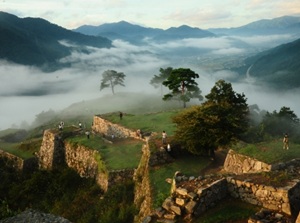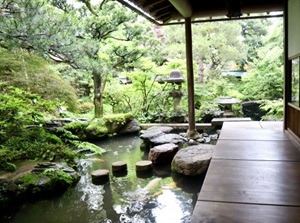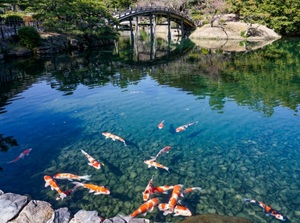What will you see in Japan?
Cities & Towns
Large city
Old city & town
Traditonal Structures
Japanese castle
Japanese garden
Shinto shrine
Buddhist temple
Nature & Onsen
Sea & Islands
Mountains & Lakes
Rivers, Gorges & Waterfalls
Plants & Animals
Onsen resorts
Various sightseeing objects
World Heritage Sites
Major Festivals
Japanese cuisine
Cities & Towns
Large cities

Shibuya in Tokyo

Dotonbori in Osaka
There are 12 large cities with over one million in population in Japan.
Tokyo is the capital of Japan and is overwhelming big.
It is the main entrance city to travel in Japan.
The other large cities are the center of each region in Japan, and they are the entrances of your travel in the region.
Old cities & towns

A street of Gion in Kyoto

Shirakawa-go in Gifu Pref.
In the Middle Ages, many samurai warriors were dotted in all parts of Japan except Hokkaido and Okinawa islands and they reigned his territory as feudal lord.
They built the castle in the central area, and the samurais serving the lord lived around the castle.
After that, merchants and craftsmen gathered there, and castle towns were formed.
Many local cities in Japan have such histories and some cities preserve the historic atmosphere.
Traditonal Structures
Japanese castles

Himeji Castle in Hyogo Pref.

Inuyama Castle in Aichi Pref.
Japanese castles were originally military forts to battle for expanding the territory of local lord.
The castles were constructed in the 14th to 16th centuries.
It is said that the number is over 40,000 throughout Japan.
After long civil war period, Japan was unified as a nation and Edo (current Tokyo) Government was founded in 1603.
Since that, the main castles were changed to the governing base of each local area.
And many other forts were abandoned.
It is said that the number of remaining castles was 150 to 200.

The whole site of Osaka Castle
The castle site is mostly surrounded with earthen walls and stone walls, and some observation towers are set up on the walls.
And most castles have moats not to let the enemy get close.
The symbolic building in the castle site is Castle Tower.
It is the central building of the fortress, but it rather showed the power of the lord.
The outside is splendid, but the inside is the central fort to battle.
The lord of the castle lived not in the castle tower but in a palace in the castle site.
He managed the governmental affairs there.
The samurai retainers of the lord were lived near the castle.
And merchants and common people gathered around the castle, so an active castle town was formed.
That is how most main cities in Japan developed.

Ruined Takeda Castle on the hill in the sea of clouds
After the end of the feudal period by samurai, new modern government had demolished most castle towers and the additional buildings as unnecessary facilities in the 1870s.
Many of them became ruins that stone walls and moats remain.
Some castles were preserved luckily, but some of them were destroyed by air raids in the World War II, unfortunately.
Now only in 12 castles, the original castle towers are preserved.
And, some cities reconstructed the former castle tower as the symbol of the city since the 20th century.
In many castles, visitors are allowed to enter the castle tower as a tourist spot or a museum.
Japanese gardens

Kenrokuen in winter in Ishikawa Pref.

Sekitei garden of Ryoanji Temple in Kyoto
Japanese garden has been built as a yard of residence of high-ranking person, major Buddhist temple and Shinto shrine.
And, samurai lords in the middle ages built large garden in the site of the castle or the villa.
Japanese garden is a small world expressing beautiful nature.
Unlike western style garden, artificial and geometrical views are not seen.
Japanese garden may pursue the beauties of nature.

Japanese garden in Nomura family residence
(Kanazawa city)

Japanese garden in Adachi Museum of Art
(Shimane Pref.)
In many gardens, a few ponds are placed in the center of the site, and stones, rocks, trees, streams, etc. are set around the pond.
In wide garden, walkways and arbors are set up.
The type of the garden is called "Chisen-teien" (池泉庭園) in Japanese, and it is simply translated as "Water garden" in English.
And, in some gardens, colorful Nishikigoi are kept in the pond.
Nishikigoi is a species of carp and had selective breeding artificially in Japan.
It is one of the items for beauty of the garden.
Some famous gardens are constructed by using the real background landscape such as far mountains, forests, castle, etc.
It is one of landscape gardening techniques in Japan, and it is called "Shakkei" (借景) in Japanese.

Nishikigoi in the pond of Ritsurin Park
(Kagawa Pref.)

Korakuen with 'Shakkei' of Okayama Castle
(Okayama Pref.)
Another type is the garden without water, and it is called "Karesansui" (枯山水, Dry landscape).
The main part of garden is covered with white sand or gravel, and it expresses water such as sea, pond, river, etc.
And stones, rocks, trees, mosses, etc. are set up on or around it.
It is mainly seen in Zen Sect temples, so the view is abstract and meaningful.
You gaze quietly at the garden from a room, and you ask yourself what it means.
One more type of Japanese garden is "Roji" (露地, Teahouse garden).
Small garden is set up around the teahouse for the tea ceremony or on the places between the buildings in the residence.
When the visitors walk through there, they can enjoy the austere scenery.
Stepping stones to walk and water bowl to wash hands are set up in the garden.

'Karesansui' garden in Nanzenji temple
(Kyoto Pref.)

Teahouse and 'Roji' garden in Kodaiji
(Kyoto Pref.)
Shinto shrines

Itsukushima Shrine in Hiroshima Pref.

Fushimi-Inari Taisha in Kyoto
Shinto shrine is called "Jinja" in Japanese.
Large or prestigious shrines are called "xx-jingu" or "xx-taisha".
Shinto is the native religion of Japan since ancient times.
There is no doctrine and scripture, but the moral sense and social customs of Japanese people are deeply rooted in Shinto naturally.
Many gods dwell in the nature and around us and they are always watching us.
And, the soul of a dead person becomes a god, and it lives in the house as the guardian deity.
That is the idea of Shinto, so there are uncountable gods in Japan.
There are more than 80,000 Shinto shrines in Japan, so we can find them in any city, town or village.
Japanese people visit Shinto shrine to pray to the god.

Torii gate in Meiji Shrine in Tokyo

Worshippers in Yasukni Shrine in Tokyo
Shinto shrine is not a sightseeing facility.
It is the sacred place to pray for Japanese people, so you are required to act with moderation and good manner in the site.
At the entrance of Shinto shrine, "Torii" gate stands.
Two crosspieces are set on top of two upright pillars, so you can find the shrine easily.
Worshippers step forward to the front of the worship hall.
The manner of worshipping is "Twice bowing, twice clapping and one-time bowing".
It is only for a few seconds.
After worshipping, worshipper can buy the lucky charm and draw "Omikuji" (a fortune-telling slip).
Shinto shrine is open to the public.
But, several sacred areas in major shrines are prohibited to enter.
And, it is prohibited to take a picture of inside of the worship hall.
You must observe the rule.
It is said that the imperial family is the descendant of gods who created Japan in the mythical age.
Therefore, Japanese Emperor System is closely related to Shinto.
Both Shinto and Buddhism have been believed by Japanese people, and they are not conflicting religions.
About Shinto and Buddhism, see the following page.
Buddhist temples

Nanzenji temple in Kyoto

Naritasan Shinshoji in Chiba Pref.
Buddhist temple is the temple for Buddhism.
In Japanese, the end of temple name is "ji", "tera" or "dera".
Buddhism is a religion founded by Buddha in ancient India in the 6th century BC.
It was introduced to Japan through China in the the 6th century AC, and it spread throughout the country.
There are about 75,000 Buddhist temples in Japan.
Buddhist temple enshrines the statues imitating the figure of Buddha.
The priests read the sutras that Buddha preached the precepts.
According to interpretations of preaching, there are many sects in Japan.
"Zen" is also one of the sects.
The manner of worshipping is to hold the palms and fingers of both hands together and make a request to Buddha.
If a big incense burner is making smoke in front of worship hall, purify yourself by the smoke.
In Buddhism, it is said that the smoke of insence sends your wish to the heaven.
Mainly, you pray out of the main hall.
But, when you can observe the sacred rooms or experience Buddhist service inside the temple, you must take off your shoes at the entrance and enter the building.
After worshipping, worshipper can buy the lucky charm and draw "Omikuji" (a fortune-telling slip).

Worshipping in Buddhist temple

Incense burner in Sensoji in Tokyo
Buddhist temple is not a sightseeing facility.
It is the sacred place to pray, and the worshippers can see the objects of worship and the facilities.
Therefore, you are required to act with moderation and good manner in the site.
There are historic buildings, artistic Buddhist sculpture, Japanese paintings, Japanese gardens in many temples.
So, you can see many Japanese traditional arts in Buddhist temple.
In some major temples, it is prohibited to take a picture of hidden Buddhist statues and sacred facilities.
You must observe the rule.
By the way, you may find the mark "卍" on the facility in Buddhist temple.
It is a happy mark for Buddhism from ancient times, and it is also used as the map symbol for Buddhist temple in Japan.
It is not the sign of Nazi.
About Buddhism and Shinto, see the following page.
Nature & Onsen

Mt.Fuji & Lake Ashi in Hakone

Drift ice of Okhotsk Sea in Hokkaido
Sea and Islands
Japan is an island country.
The mainland consists of four large island, and and they account for over 95% of the whole of Japan.
The other small islands are around the mainland and some of them are dotted on a line in the vast ocean.
Total number of the islands in Japan is 14,125, and Japanese people live in 416 islands of them.
The land area is not so large, but the total length of the coastline is the sixth longest in the world.
The islands are dotted in wide area.
The territory reaches from subarctic zone to subtropical zone.
Because of such geographical features, various climates appear by region.
Therefore, various scenic spots and resort areas of sea are throughout Japan.
Mountains and Lakes

Northern Alps from Kamikochi

Crater of Mt.Aso volcano
Japan is a mountainous country.
In addition, there are many volcanoes because Japanese Islands is a part of the belt of volcanoes in the Pacific Ocean called "Ring of Fire".
Most lakes are dotted in the mountain and they are not so large.
Many of them were formed by volcanic activity and they are almost "caldera lake" that water has collected around the volcano.
There are many scenic mountains throughout Japan.
Some mountains have been worshiped as god since ancient times, so there are sacred Shinto shrines and Buddhist temples.
And, some mountains have onsen resorts.
In addition, popular ski resorts are around some mountains.
Mountains and lakes are also good sightseeing spots.
Rivers, Gorges and Waterfalls
Japan is an island country and the shape of land is narrow and long.
The whole area is mountainous and there are a lot of rain, so many rivers flows out the mountains.
But the distances to the sea are short.
The longest river in Japan is Shinano River flowing to Niigata Prefecture, and the lenght is 367 km.
The second longast river is Tone River.
Even though it flows through the widest Kanto Plain with Tokyo and many cities, the lenght is 322 km.
In the mountain area, many rivers flow rapidly and pure water flows.
They formed various gorges and waterfalls.
Plants & Animals
In such land, there are various fields and forests and various plants and animals are seen.
Onsen resorts
There are about 1,500 active volcanoes in the world, and 111 of them are in Japan.
As the benefit of them, there are many hot springs (Onsen in Japanese).
Visiting Onsen has been one of popular leisures of Japanese people since the old times.
Various sightseeing objects
World Heritage Site
World Heritage Sites are landmarks and areas with legal protection under an international treaty administered by UNESCO.
In Japan, 26 World Heritage Sites are designated and many of them are the popular sightseeing spots.
Major festivals in Japan
In Japan, various festivals are held in many cities and towns.
Most festivals are for Shinto shrine, and have a long history.
The festivals in main cities are popular, and many tourists visit the city to see the festival.
Japanese cuisine
Japanese cuisine is popular with foreign tourists.
There may be Japanese restaurants in your country.
But it is natural that you can eat real Japanese foods in Japan.
Maybe, you will recognize that the tastes of the foods in Japan are different from Japanese foods in your country.
First, let's have knowledge of Japanese cuisine and the restaurant.

